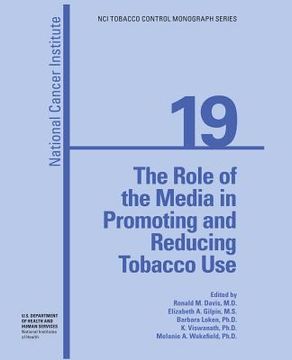Synopsis "The Role of the Media in Promoting and Reducing Tobacco Use (in English)"
The National Institutes of Health Publication 07-6242, The Role of the Media in Promoting and Reducing Tobacco Use, NCI Tobacco Control Monograph 19, (the 19th of the Tobacco Control Monograph series of the National Cancer Institute (NCI) provides a critical, scientific review and synthesis of current evidence regarding the power of the media both to encourage and discourage tobacco use. The work presented is the most current and comprehensive distillation of the scientific literature on media communications in tobacco promotion and tobacco control. The six main parts of this monograph deal with aspects of media communications relevant to tobacco promotion and tobacco control. Part 1, an overview, frames the rationale for the monograph's organization and presents the key issues and conclusions of the research as a whole and of the individual chapters. This section describes media research theories that guided this assessment of the relationship between media and tobacco use, which can be viewed as a multilevel issue ranging from consumer-level advertising and promotion to stakeholder-level marketing aimed toward retailers, policymakers, and others. Part 2 further explores tobacco marketing-the range of media interventions used by the tobacco industry to promote its products, such as brand advertising and promotion, as well as corporate sponsorship and advertising. This section also evaluates the evidence for the influence of tobacco marketing on smoking behavior and discusses regulatory and constitutional issues related to marketing restrictions. Part 3 explores how both the tobacco control community and the tobacco industry have used news and entertainment media to advocate their positions and how such coverage relates to tobacco use and tobacco policy change. The section also appraises evidence of the influence of tobacco use in movies on youth smoking initiation. Part 4 focuses on tobacco control media interventions and the strategies, themes, and communication designs intended to prevent tobacco use or encourage cessation, including opportunities for new media interventions. This section also synthesizes evidence on the effectiveness of mass media campaigns in reducing smoking. Part 5 discusses tobacco industry efforts to diminish media interventions by the tobacco control community and to use the media to oppose state tobacco control ballot initiatives and referenda. Finally, Part 6 examines possible future directions in the use of media to promote or to control tobacco use and summarizes research needs and opportunities. Key lessons from this volume can inform policymakers as well as scientists and practitioners. Most critical from a policy standpoint is the conclusion, supported by strong evidence, that both exposure to tobacco marketing and depictions of tobacco in movies promote smoking initiation. In the United States in 2005-the same year in which 2.7 million American adolescents aged 12 to 17 used cigarettes in the past month1 and 438,000 Americans died prematurely from diseases caused by tobacco use or secondhand smoke exposure2-the tobacco industry spent $13.5 billion (in 2006 dollars) on cigarette advertising and promotion,3 an average of $37 million per day. The tobacco industry continues to succeed in overcoming partial restrictions on tobacco marketing in the United States, and tobacco marketing remains pervasive and effective in promoting tobacco use. Efforts to curb the depiction of tobacco use in movies have increased in recent years, and the evidence reviewed here indicates that progress in this area could be expected to translate into lower rates of youth smoking initiation in the future. Strong evidence indicates that media campaigns can reduce tobacco use. This volume highlights the complexities of assessing the media's influence on tobacco-related attitudes and behavior. A vast range of research is reviewed.

